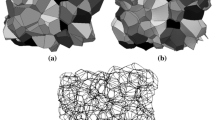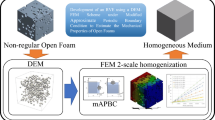In this study, the geometry of open-cell foams is simulated using a model based on Voronoi tessellations. The fracture toughness of open-cell foams with Voronoi cells, including Mode-I, Mode-II, and the mixed-mode ones, are calculated by the finite-element method based on a micromechanical model. Cracks in the micromechanical model are created through removing some number of cells pertaining to the crack length. Displacement boundary conditions are applied to the boundary of a small region surrounding the crack tip, which are calculated based on the linear elastic fracture mechanics. The effects of relative density, disorder factor and sample size on the predicted elastic properties and fracture toughness of open-cell foams with Voronoi cells are discussed and compared with results available in the literature.






Similar content being viewed by others
References
R. Phelan, D. Weaire, and K. Brakke, “Computation of equilibrium foam structures using the surface evolver,” Experimental Mathematics, 4, 181-192 (1995).
D. Baillis and J. F. Sacadura, “Thermal radiation properties of dispersed media: theoretical prediction and experimental characterization,” J. Quantitative Spectroscopy & Radiative Transfer, 67, 327-363 (2000).
K. Boomsma and D. Poulikakos, “On the effective thermal conductivity of a three-dimensionally structured fluid-saturated metal foam,” Int. J. Heat Mass Transfer, 44, 827-836 (2001).
A. Bhattacharya, V. V. Calmidi, and R. L. Mahajan, “Thermophysical properties of high porosity metal foams,” Int. J. Heat Mass Transfer, 45, 1017-1031 (2002).
D. Edouard, “The effective thermal conductivity for “slim” and “fat” foams,” Am. Institute of Chemical Engineers, 57, No. 6, 1646-1651 (2011).
H. T. Truong, M. Lacroix, C. H. Pham, et al., “Towards a more realistic modeling of solid foam: Use of the pentagonal dodecahedron geometry,” Chem. Eng. Sci., 64, 5131-5142 (2009).
M. W. D. Van der Burg, V. Shulmeister, E. Van der Geissen, et al., “On the linear elastic properties of regular and random open-cell foam models,” J. Cellular Plastics, 33, No. 1, 31-54 (1997).
J. E. Li and B. L. Wang, “Equivalent thermal conductivity of open cell ceramics foams at high temperatures,” Int. J. Thermophys., 35, 105-122 (2014).
R. Coquard, D. Rochais, and D. Ballis, “Conductive and radiative heat transfer in ceramic and metal foams at fire temperatures,” Fire Technol., 48, 699-732 (2012).
C. C. Tseng, R. L. Sikorski, R. Viskanta, and M. Y. Chen, “Effect of foam properties on heat transfer in open-cell foam inserts.” J. Am. Ceramic Soc., 95, No. 6, 2015-2021 (2012).
M. Loretz, R. Coquard, D. Bailli, et al, “Metallic foams: radiative properties comparison between different models,” J. Quantitative Spectroscopy & Radiative Transfer, 109, No. 1, 16-27 (2008).
A. Kaemmerlen, C. Voc, F. Asllanaja, G. Jeandela, and D. Baillis, “Radiative properties of extruded polystyrene foams: predictive model and experimental results,” J. Quantitative Spectroscopy & Radiative Transfer, 11, 865-877 (2010).
P. C. Tseng and H. S. Chu, “An experimental study of the heat transfer in PS foam insulation,” Heat Mass Transfer, 45, 399-406 (2009).
S. K. Nammi, P. Myler, and G. Edwards, “Finite-element analysis of closed-cell aluminium foam under quasi-static loading,” Mater. Des., 31, No. 2, 712-722 (2010).
Y. An, C. Wen, P. Hodgson, et al, “Investigation of Cell Shape Effect on the Mechanical Behaviour of Open-cell Metal Foams,” Computational Mater. Sci., 55, No. 5, 1-9 (2012).
U. E. Ozturk and G. Anlas, “Finite-element analysis of expanded polystyrene foam under multiple compressive loading and unloading,” Mater. Des., 32, No. 2, 773-780 (2011).
J. B. Sha, T. H. Yip, and M. H. Teo, “FEM Modelling of single-core sandwich and 2-core multilayer beams containing foam aluminum core and metallic face sheets under monolithic bending,” Progress in Natural Sci.: Mater. Int., 21, No. 2, 127-138 (2011).
P. Thiyagasundaram, B. V. Sankar, and N. K. Arakere, “Elastic properties of open-cell foams with tetrakaidecahedral cells using finite-element analysis,” AIAA J., 48, No. 4, 818-828 (2010).
S. K. Maiti, M. F. Ashby, and L. J. Gibson, “Fracture-toughness of brittle cellular solids,” Scr. Metall, 18, 213-217 (1984).
J. S. Huang and L. J. Gibson, “Fracture-toughness of brittle foams,” Acta Metall. Mater., 39, 1627-1636 (1991).
J. S. Huang and L. J. Gibson, “Fracture-toughness of brittle honeycombs,” Acta Metall. Mater., 39, 1617-1626 (1991).
R. Brezny and D. J. Green, “The effect of cell-size on the mechanical-behavior of cellular materials,” Acta Metall. Mater., 38, 2517-2526 (1990).
R. Brezny and D. J. Green, “Factors controlling the fracture-resistance of brittle cellular materials,” J. Am. Ceram. Soc., 74, 1061-1065 (1991).
R. Brezny, D. J. Green, and C. Q. Dam, “Evaluation of strut strength in open-cell ceramics,” J. Am. Ceram. Soc., 72, 885-889 (1989).
L. J. Gibson and M. F. Ashby, Cellular Solids: Structure and Properties, Cambridge University Press, UK (1997).
S. Choi and B. V. Sankar, “Fracture toughness of carbon foam,” J. Compos. Mater., 37, 2101-2016 (2003).
S. Choi and B. V. Sankar, “A micromechanical method to predict the fracture toughness of cellular materials,” Int. J. Solids Struct., 42, 1797-1817 (2005).
J. Wang, “Fracture toughness of cellular materials using finite-element based micromechanics,” Doctoral Dissertation, University of Florida, Gainesville, Florida (2007).
P. Thiyagasundaram, J. Wang, B. V. Sankar, et al., “Fracture toughness of foams with tetrakaidecahedral unit cells using finite-element based micromechanics,” Eng. Fracture Mech., 78, No. 6, 1277-1288 (2011).
F. Aurenhammer, “Voronoi diagrams – a survey of a fundamental geometric data structure,” ACM Computing Surveys, 23, No. 3, 345-405 (1991).
L. J. Gibson and M. F. Ashby, Cellular Solids: Structure and Properties, Pergamon Press, Oxford (1988).
H. X. Zhu, J. F. Knott, and N. J. Mills, “Analysis of the elastic properties of open-cell foams with tetrakaidecahedral cells,” J. Mech. Phys. Solids, 45, No. 3, 319-343 (1997).
W. E. Warren and A. M. Kraynik, “The linear elastic properties of open-cell foams,” J. Appl. Mech., 55, 341-346 (1988).
A. P. Roberts and E. J. Garboczi, “Elastic properties of model random three-dimensional open-cell solids,” J. Mech. Phys. Solids, 50, 33-55 (2002).
G. C. Sih and H. Liebowitz, Mathematical Theories of Brittle Fracture, Academic Press, New York–London (1968).
Acknowledgements
This research was supported by the National Science Foundation of China (Project No. 11502101) and the Jinling Institute of Technology Research Innovation Foundation, China (Project No. jit-b-201515). The authors are very grateful to the anonymous referee for providing a number of comments on their manuscript, which were very useful for improving the quality and presentation of the final paper.
Author information
Authors and Affiliations
Corresponding author
Additional information
Russian translation published in Mekhanika Kompozitnykh Materialov, Vol. 54, No. 6, pp. 1137-1152, November-December, 2018.
Rights and permissions
About this article
Cite this article
Li, J.E., Wang, B.L. & Guo, S.L. Numerical Analysis of the Fracture Toughness of Low-Density Open-Cell Voronoi Foams. Mech Compos Mater 54, 789–798 (2019). https://doi.org/10.1007/s11029-019-9783-7
Received:
Published:
Issue Date:
DOI: https://doi.org/10.1007/s11029-019-9783-7




